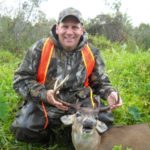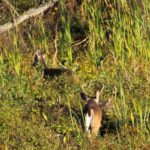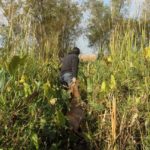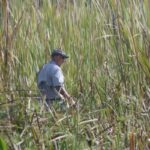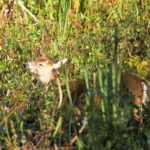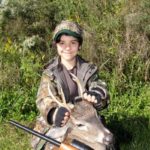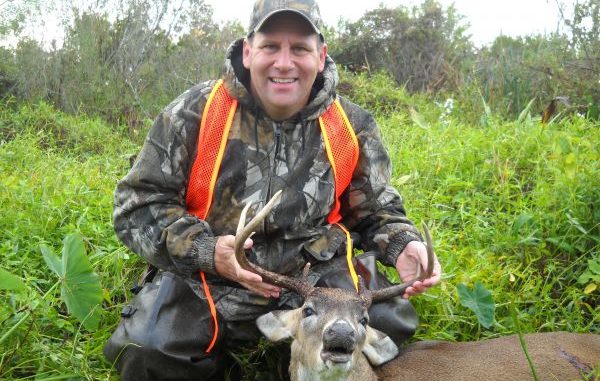
If you’re deer lease is along Louisiana’s coast, you know tracking is much more difficult than in drier environs. Here are some thoughts on how to find that deer after the shot.
Somewhere between my stand on the edge of the marsh and the canal bank behind me, I heard a deer. It was working its way through a tangle of briars and scrub myrtle trees to which I normally paid little attention.
My initial thought was there wasn’t any need to worry about what was happening behind the stand. The canal bank was very narrow and nothing could get through that stuff, while everything would — had to — pass out in front of me.
What’s more, all of the deer trails in the marsh funneled to one main trail where the stand in which I now sat was strategically placed to bushwhack my quarry.
So I thought.
Obviously, this was wrong thinking that missed the “what if” part of Marsh Stand Location 101.
Straining my neck to get a glimpse of the animal, I could see it was a doe. But there was more movement that could be heard a few decibels above the birds that were well into their sunrise feeding frenzy, making quite a racket I might add.
I strained to pick up the deer sound as yellow rumped warblers, juncos, blue-gray gnatcatchers and savannah sparrows flitted tree to tree and bush to bush.
The southerly breeze flowing from the Gulf of Mexico wafting through the willows didn’t help, either — funny how noisy leaves can be when you’re concentrating on sound.
Suddenly, I heard the slow, rhythmic sploosh and suction of a heavy deer’s hooves that told me this had to be a buck — and it was.
Only the ivory white of its horns stood out when the buck reached the briars where the doe had passed moments prior. Its winter color matched the dead-leaf browns and tans of the frost-bitten flag grass, cattails and scrub maple leaves. The shadows from the nearby stand of tallow trees made it nearly impossible to make out its body.
The buck was methodically trailing the doe like a bloodhound — not really pushing her. Looking beyond it, I thought that, just maybe, when it reached the tallow trees if it turned in the right direction I’d get my chance.
It would be a close shot: maybe 35 or 40 yards.
An invasive species, tallow trees in the marsh grow in thick bunches along canal banks. Young stands of tallows sometimes are less than a foot apart, acting like pickets that stop people from passing.
It was between these trees the buck turned broadside.
“You can squeeze a shot in there,” said the devil on my right shoulder, looking at the deer’s flesh front to back, where seemingly it looked like it stood behind the bars of a jail cell.
“No you can’t,” the angel on the other said.
“You’ve done it before,” the rebellious one countered.
“You’ve missed before, too,” the good side replied with a cautious tone.
“You’re losing your confidence. Just squeeze the trigger,” I said this time.
Baammm!
The deer leapt straight up and ran. No worries: I’d seen this countless times. This was no different.
Giving the deer plenty of time to expire, a half hour later I got down from my stand to sort things out.
Getting to the location where I shot at the buck, my first instinct, like most hunters, was to look for blood — the telltale sign of a hit.
Only, there was none.
And the cluster of tallow trees revealed no destroyed bark from a bullet impact that would perhaps reveal a miss.
Dumbfounded, I stared at the ground.
There: Appearing before me, were two rear hoof prints dug deep in the canal bank’s gooey black mud from its vertical leap. Looking ahead a couple feet, I could see the landing prints, along with a couple of others that showed the deer’s goal was to put distance and cover between it and me.
There is no other state in America where such terrain exists. Flotant (prounounced flow-tawnt by locals) is literally floating marsh that is not anchored in its root system. In it, a deer’s hooves work as four-pronged walking sticks, keeping them above ground on a surface in which humans readily sink waist deep.
My fear would be the deer would use the wet muddy canal bank’s solid ground, with its mix of nasty briars, thick myrtles and tallow trees to hide its escape and then head out into a deer-road infested flotant marsh. Here, the deer trails — known as deer roads by marsh hunters — look like veins, with the vegetation worn down to muddy paths packed with tracks.
That fear was also compounded by the fact that not only is the marsh wet and boggy but there are also numerous pipeline ditches and small bayous a deer can cross. Not only do these crossings wash blood off a deer’s hide, they also become additional obstacles for the tracker to overcome.
In short, the Louisiana coastal marsh can be a nightmare when it comes to tracking, when there are so many hindrances and little to no blood found.
Where marsh hunters go wrong is they give up when a wounded deer hits a trail where you can’t put another track.
But there are tactics that can help you sort out and find your deer.
Bobby Aucoin, though only 25 years old, has hunted the marsh on Avoca Island near Morgan City with his father and brothers since he was old enough to walk.
And, while Aucoin said he personally hasn’t lost many deer, he learned the art of tracking from family and friends who have.
“You can tell if a deer is hurt or not,” he explained. “And when a deer is not bleeding, in the marsh you have to look for and rely more on its prints in the mud. Tracks that go straight — off in one direction — like when something is after him — will be deeper in the mud.
“A marsh deer that’s wounded won’t run in a consistent direction like that; he’ll run in circles.”
The key to finding wounded deer in this environment is close observation.
“… (I)f you look at a wounded deer’s track closely, you can tell a lot from it,” Aucoin said. “Depending on where it is hit, one or more of its tracks may be turned and not straight — or it will stumble.
“I’ve learned from experience that when a deer’s track is turned in, usually it is a wounded deer.”
Patterson local Rhett Granier loves to bow hunt, and he noted that few deer — even with lethal hits from a bow — ever drop in their tracks. Because of this fact, he said he has had to track quite a few in his lifetime.
“It’s hard tracking deer in the marsh, especially when you don’t have much blood,” said Granier, who also annually bow hunts deer on public land in the upland regions of Missouri, along with hunting the Atchafalaya Delta Wildlife Management Area marsh. “One of the things a wounded marsh deer does is run in circles trying to find a place to lie down. It becomes disoriented.
“If possible, what I do first is go get some help. One person can stand where the last sign was found, and the other person can work a circular pattern starting small and work farther out each time. A deer will walk over his own track, making it harder yet to find. So by working circles, two guys are able to more thoroughly cover the area a wounded deer has gone.”
Aucoin and Granier recommended using a dog in difficult tracking conditions.
Centerville resident James Wilson told the story of shooting a doe with buckshot one season on his lease in the marsh near Burns Point. There was little blood sign from the hard-hit deer, and the track became impossible to follow in the marsh, as it mixed with others going in both directions in the deer roads.
Discouraged, Wilson went home to get a buddy to help. His father-in-law, who lived next door, suggested he might take his Jack Russel, Maggie, with him.
“Maggie was always chasing squirrels in the yard, and my father-in-law said, ‘Why don’t we take her?’” Wilson said. “So I did, just for the heck of it.
“When I put her on the track, she made a circle in the marsh and came right back to the stand.”
Wilson quickly discounted the dog’s tracking abilities.
“I thought the dog was useless to us, when my buddy Eddie Darce said to let her go (because) she might be on something,” Wilson said. “The deer had made a circle through the tall flag grass going right past my stand while I was tracking her.
“We wound up finding the deer bedded down in a thick stand of myrtle trees, laying down in about 6 inches of water.
“I tell everyone now that Maggie is my girl. Next time I’ll believe her.”
One thing common to all whitetail deer is they don’t like to be far from cover. Moreover, marsh deer have little trouble finding hiding places.
In fact, unlike other regions of the country — where farm fields have fence row edges along corn fields or there’s open, grassy meadows on hillsides, and even old growth timber with high visibility —the marsh has thick stands of flag grass, cut grass, cattails and patches of roseau thickets that deer disappear in.
Some but not all land companies allow hunters to use airboats to break shooting lanes that offer clear shots. But wounded deer always run for the thickest cover.
So prior to the season, when looking for deer sign to set up a stand, marsh hunters should make note of escape routes leading to the heaviest cover. Quite often, this will reduce a tracking job because you’ll know where a deer is going rather than sorting it out step-by-step after an arrow is released or a poor shot from a firearm is made.
Wounded deer will stumble, often breaking flag grass in the marsh.
One trick I’ve learned is to squat down to have a deer’s view when looking at a deer road. This perspective often lets your eyes see little things that will give you hope on a tough trail.
Flag and cut grass almost always break in the direction the deer is going. On more than one occasion, finding a single broken blade of flag grass has given me courage to stay on the trail.
As I followed my buck, every so often — and by “so often” I mean 20 or 30 meticulous yards — I’d find a drop of blood no larger than a pea.
The blood wasn’t the large spot of frothy kind that indicated a lung shot. It wasn’t the brownish kind from a gut shot. And it wasn’t the rich red of an artery shot.
Never did I find a pool of blood from a deer that would lie down. Nor did I find blood 20 to 30 inches off the ground where the deer might have leaned on something.
It was simply the occasional pea-size drop that was more like a shaving nick.
But, to call yourself a hunter, you have to make every effort to recover a deer.
Never did I find its track became erratic, nor did I find that it went in a circle.
I tracked slowly and methodically for more than four hours around two canal banks and across a vast expanse of open marsh. I estimated I had walked and studied the deer’s trail for over a half mile until I reached a wide bayou that it swam.
“Ole boy, it looks like you have won the day,” I said to the spirits of the marsh.
